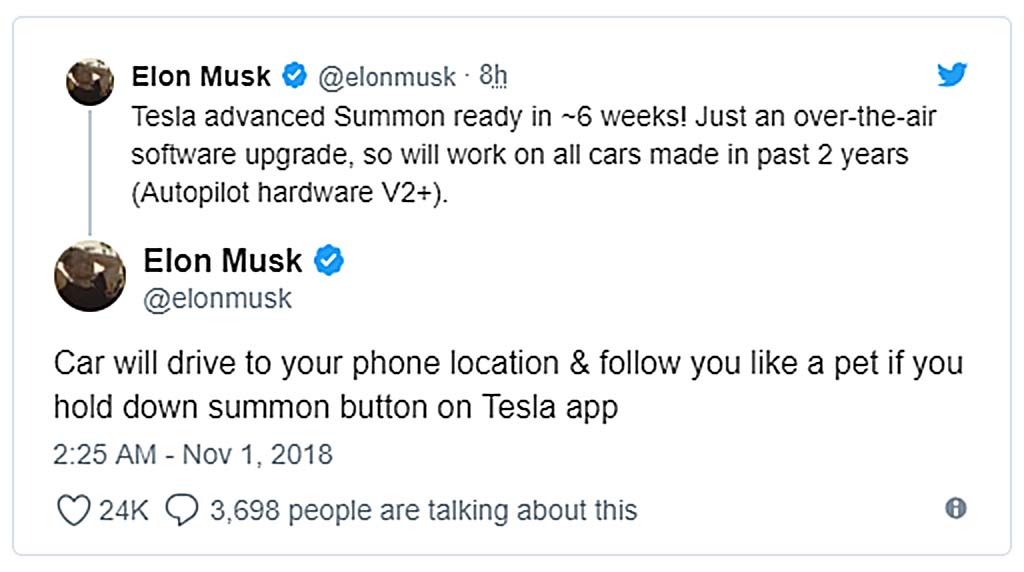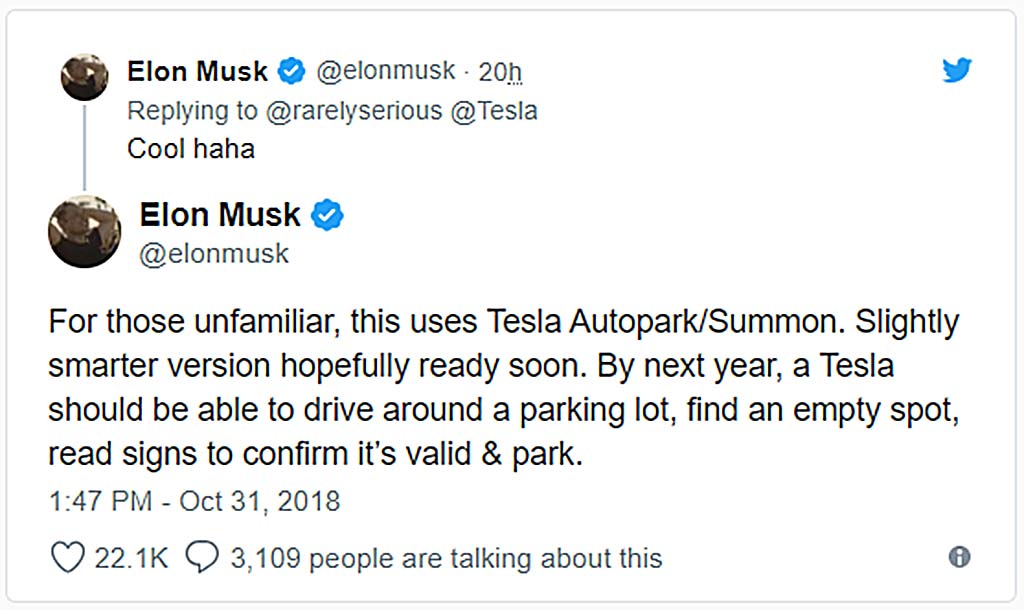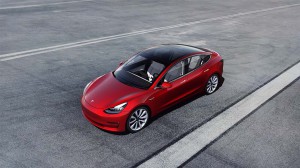Tired of circling around a parking lot looking for an open spot, perhaps missing a meeting while you wait? Or perhaps you want to don’t want to have to traipse back in snow or rain?
Tesla plans to solve those problems with a series of update that CEO Elon Musk said will start rolling out within six weeks for owners of recently built versions of its products. Upgrading the existing version of Tesla’s “Summon” auto-park feature, it will let a driver get out of their vehicle and then send it off to find a valid parking spot all on its own.
Noting it will simply require an over-the-air software upgrade,” Musk tweeted on Halloween eve that the new feature “will work on all cars made in past 2 years.”
(Faraday Future “effectively insolvent,” says co-founder. Click Here for the story.)
The update will work on vehicles equipped with Tesla’s second-generation Autopilot hardware, which was introduced in October 2016, The initial upgrade will require owners to remain within line of the vehicle, though he suggested an even more sophisticated version of the software will come “by next year.”
 At that point, the 47-year-old executive added, properly equipped and updated Tesla models will be able to not only find an empty spot in a parking lot but read signs and markings to ensure it pulls into a legal space. That would avoid a penalty, for example, for pulling into a spot marked “Handicapped.”
At that point, the 47-year-old executive added, properly equipped and updated Tesla models will be able to not only find an empty spot in a parking lot but read signs and markings to ensure it pulls into a legal space. That would avoid a penalty, for example, for pulling into a spot marked “Handicapped.”
While technologically possible, it is actually unclear where the new features will be legally viable. Federal regulations expanding the use of autonomous and semi-autonomous vehicle technologies continue to slowly move through Congress. Until such a bill is approved and signed into law, however, local regulators have sway on what happens in individual states and cities.
More than half of the states have now approved some self-driving rules, though most require vehicles not only get a special permit or license plate but that an “operator” remains behind the wheel, ready to take control in the event of an emergency.
Those are reasons why several other automakers have yet to push through their own remote parking technologies, including both BMW and Volvo.
(Click Here for a list of the Green Car of the Year finalists.)
 The German automaker has demonstrated its own remote control parking system on several vehicles, including the latest-generation 5-Series and is now rolling it out on a limited basis, apparently focusing on markets where the regulations clearly permit its use. That includes the UK, where revisions approved by the Drive and Vehicle Standards Agency went into effect last June. The BMW system appears to be similar to what the first update will allow Tesla products to do, a driver exiting the vehicle but keeping it clearly in sight as it pulls into a garage or parking spot.
The German automaker has demonstrated its own remote control parking system on several vehicles, including the latest-generation 5-Series and is now rolling it out on a limited basis, apparently focusing on markets where the regulations clearly permit its use. That includes the UK, where revisions approved by the Drive and Vehicle Standards Agency went into effect last June. The BMW system appears to be similar to what the first update will allow Tesla products to do, a driver exiting the vehicle but keeping it clearly in sight as it pulls into a garage or parking spot.
More limited auto-park systems are now widely available from manufacturers as diverse as Ford and Mercedes-Benz. Those systems use various types of sensors, including sonar, vision and radar, to help a vehicle slide into a parallel or perpendicular spot and, in some cases, exit the spot, as well. But a driver must remain behind the wheel and, in some instances, operate the brakes or throttle, leaving steering up to the vehicle itself.
(GM asks for relief on fuel rules while betting big on EVs. Click Here for the story.)

